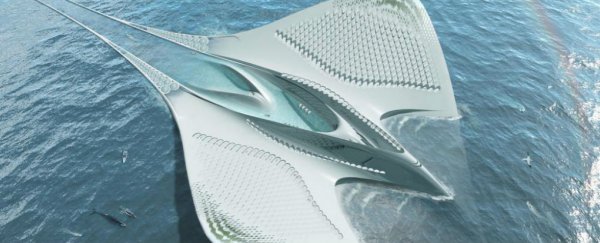Dreamed up by French architect Jacques Rougerie, this is the City of Mériens - a giant floating city designed to give scientists a place to live while they conduct research on the surrounding ocean. The futuristic research facility would stretch 900 metres by 500 metres, and would house up to 7,000 scientists and students from all over the world, offering them an array of laboratories, classrooms, lecture halls, living quarters, and dedicated areas for leisure activities and sports, to facilitate long-term research projects.
"Considering the dimension and size of the international scientific community - 7,000 people spread on the entire structure - I designed the City of Mériens in the form of a manta ray because it was the best design to accommodate such a community with regards [to] the best possible correlation between space and stability needs," Rougerie told Weather.com.
The manta ray design was selected because of its ability to resist turbulence from storms and other harsh weather conditions. While the visible structure is just 60 metres tall, it plunges up to 120 metres below the surface of the ocean, which helps to keep the whole thing steady.
The shape also allows for a large lagoon to be hosted in the centre of the facility, into which roving research vessels such as SeaOrbiters - also designed by Rougerie - can be parked, and on either side of its access channels there'll be space for aquaculture breeding farms where scientists can cultivate and study various marine species. The tips of the vessel's 'wings' would house hydroponic greenhouses for growing all the fruits and vegetables the residents will need right there onboard.
"People would come [from] all over the world - it's an international city governed by United Nations standards. It's destined for researchers, academics and students who wish to explore and study the ocean," Rougerie says of his vision for the floating city. "[It] would revolutionise the world of underwater studies due to the fact that people would have a permanent contact with the ocean, as well as a direct access to the underwater world, as part of the City is completely underwater."
 Jacques Rougerie Foundation
Jacques Rougerie Foundation
As Noémie Jennifer reports for The Creator's Project, the whole thing is designed to be 100 percent sustainable and autonomous, running on renewable marine energy and producing zero waste. While it's not yet clear how Rougerie plans on achieving this, the energy side of things could work along the lines of this grid-connected wave power station, which was recently launched off the coast of Western Australia.
Myles Gough explained how it worked back in February:
"The round, submerged buoys are tethered to seabed pump units, which are installed at a depth of between 25 and 50 metres. Waves crashing into the buoys drive the pumps, which push pressurised seawater through a pipeline beneath the ocean floor to an onshore hydroelectric power station. Here, the high-pressure water drives a turbine and generates electricity."
So far, the City of Mériens is purely conceptual, but Rougerie wants it to be constructed and ready for researchers to move in by 2050. This might seem a little too ambitious - and it probably is - but the sea-loving architect has already started construction on his revolutionary SeaOrbiter floating lab, so he might actually put his money where his mouth is where his floating city is concerned.
As Tech Insider reports, when complete, the SeaOrbiter will have 12 floors - six of which will be below sea level - and will cost $50 million to make. The first one is expected to be operational by 2016.

